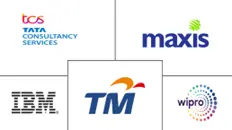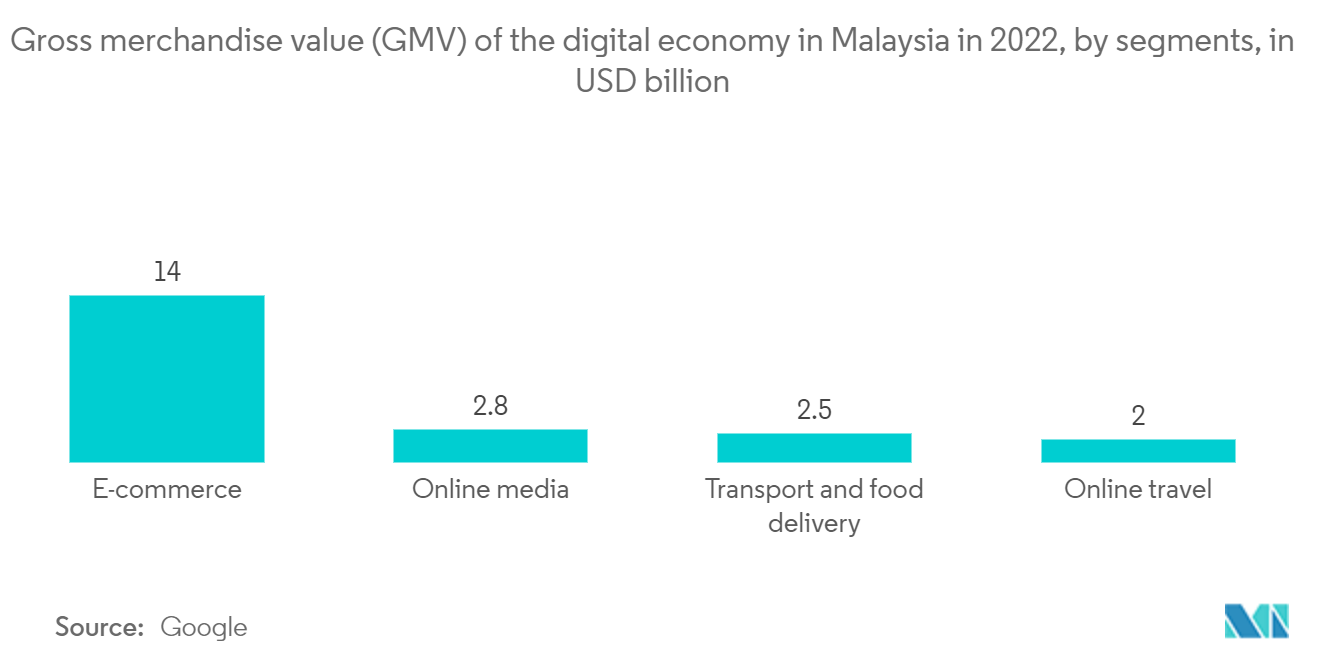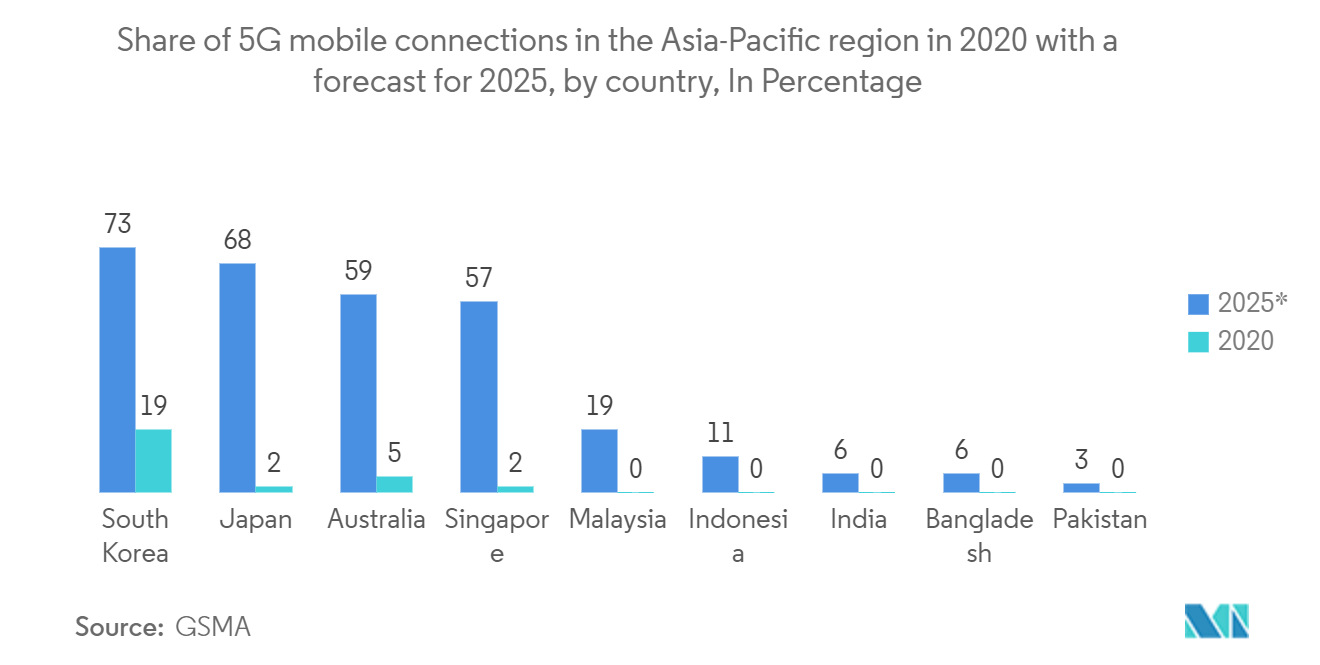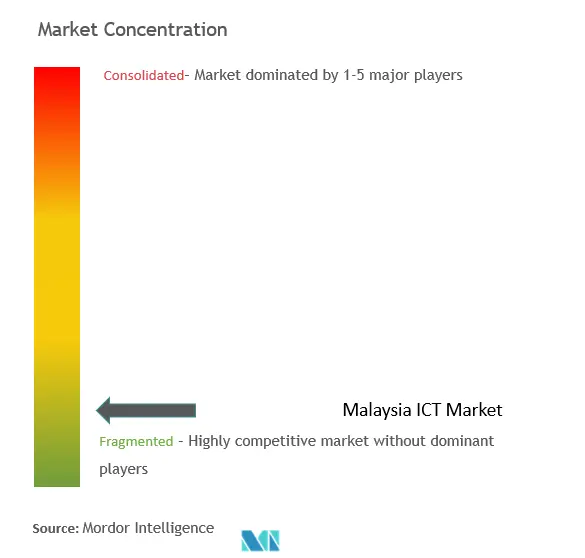Malaysia ICT Market Size

| Study Period | 2019 - 2029 |
| Base Year For Estimation | 2023 |
| Market Size (2024) | USD 27.20 Billion |
| Market Size (2029) | USD 39.18 Billion |
| CAGR (2024 - 2029) | 7.57 % |
| Market Concentration | Low |
Major Players
*Disclaimer: Major Players sorted in no particular order |
Malaysia ICT Market Analysis
The Malaysia ICT Market size is estimated at USD 27.20 billion in 2024, and is expected to reach USD 39.18 billion by 2029, growing at a CAGR of 7.57% during the forecast period (2024-2029).
The increased digitalization of processes across all significant industrial sectors is mainly responsible for this growth. Also, compared to other Asian neighboring nations, Malaysia is expected to witness a comparatively high broadband penetration.
- The demand for ICT goods and services would continue to be high, mainly attributable to the rollout of 5G, hybrid business models, digital banking, and consumers who keep up with the newest trends. According to the Department of Statistics Malaysia (DOSM), ICT contributed 23.2% of Malaysia's gross domestic product (GDP) in the last year, with an increase of 12.1% from the past year. As per the report, e-commerce in the ICT sector contributed 3.8% to GDP, while e-commerce in other sectors contributed 9.2%.
- The Economic Stimulus Package of the Malaysian government offers significant financial incentives for digital transformation, connectivity, security, satellite broadband, digital infrastructure for buildings, 5G ecosystems, and process automation. After the pandemic, the government's focus started focusing more on modernizing and standardizing Malaysia's industrial sector and worldwide supply chain network, which is likely to result in a further increase in demand for automation and digitalization exports.
- However, it is crucial to overcome some significant obstacles to secure the long-term survival of Malaysia's businesses in the post-pandemic world and beyond. The expense of funding or digitizing is one of the biggest obstacles. These costs include software subscriptions, digital devices, and internet connectivity.
- The robust core government policies, high-tech-focused national development, and accessibility of trained labor in the Malaysian ICT market have helped the sector thrive in the nation. Notably, the government has given the Internet of Things (IoT) sub-sector significant attention, which has led to several market alliances.
- Work-from-home (WFH) arrangements used under Covid-19 have increased ICT goods and services sales in Malaysia. Today, technology is employed everywhere in our daily lives, from communications to decision-making. Not only is digitalization the foundation of the economy, but it is also quickly evolving into the foundation of society. The government is battling to keep up with the rapid speed of digitalization while sustaining, directing, and offering support for the economy and society to grow with the technologies.
Malaysia ICT Market Trends
This section covers the major market trends shaping the Malaysia ICT Market according to our research experts:
Poised to Become the Digital Hub of Asia
- Malaysia has long been a leader in the transition to the digital world. The obstacles associated with digitalization have been solved throughout the years by expanding countrywide connectivity, improving the flow and processing of data, and creating strong links between cutting-edge technology.
- The improved and redesigned project that succeeds MSC Malaysia is now called Malaysia Digital (MD). By ensuring equal access to digital resources, information, and employment opportunities, this new program would accelerate the development of Malaysia's digital economy and generate significant digital economic spillover. Malaysia Digital would spearhead the digital transformation of crucial target sectors with considerable development potential.
- Nine target sectors have been designated under Malaysia Digital as having strong development potential, opportunity, and significance for advancing Malaysia's upcoming digital economic transition. The nine categories are trade, agriculture, services, cities, health, finances, content, tourism, and the Islamic digital economy.
- Malaysia aspires to be a digital powerhouse for the region and a sustainable country. It is eager to increase the country's appeal to entrepreneurs and investors. To aid in the effort to accelerate the expansion of the country's digital economy, two Malaysian Digital Catalytic Programs were created.
- DE Rantau, an initiative that the Minister of Communications and Multimedia recently unveiled, aims to make Malaysia the preferred hub for digital nomads to increase digital adoption and foster professional mobility and travel around Malaysia. Digital trade attempts to promote interoperability, improve regulatory methods and standardization, and ease local and international commerce.
- According to the Minister of Communications and Multimedia Malaysia, MDEC would endeavor to spur the development of the digital ecosystem and ensure ongoing investments from technology businesses through strategic initiatives as the country's recognized agency for promoting digital assets.
- According to Google research, Malaysia's digital economy's gross merchandise value (GMV) was 21 billion USD in the current year. The country's e-commerce sector, which generated USD 14, made up the majority of the GMV of the digital economy, which was then boosted by online media, transportation, and food delivery.

Steady Pick Up of 5G
- The digital economy is supported in large part by 5G. To realize 5G, a government-controlled 5G single wholesale network by Digital Nasional Berhad (DNB), owned by the Malaysian Ministry of Finance, was established in March 2021 to deploy 5G infrastructure and extend 5G as a wholesale network.
- Although Malaysia's ambition for 5G has witnessed several setbacks, yet again, it is back on track with enhanced network coverage. The launch of Malaysia's fifth generation (5G) network is expected to benefit users in various ways if all goes according to plan. Malaysia is now moving to 5G, which has the potential to change how the nation's mobile technology operates completely.
- By 2025, Malaysia is predicted to have 2.1 million 5G customers, or 6.6 5G subscribers for every 100 residents, according to the Malaysian Investment Development Authority. By that time, Malaysia's gross domestic product is expected to benefit from 5G to the tune of RM5.3 billion (USD 1.1 billion).
- Over 30% of Malaysia's population currently has access to 5G, and the country is on course to meet the government's 80% coverage goal by 2024. To build out the nation's 5G services, four mobile carriers in Malaysia, namely Celcom, Digi, YTL, and TM, have finally sealed arrangements to obtain 65% of the government-owned 5G agency, Digital Nasional Berhad (DNB).
- Future 5G technology is extremely promising for moving Malaysia's smart city initiatives ahead. A smart city makes use of new and existing technologies, including 5G, the Internet of Things (IoT), big data, the cloud, edge computing, artificial intelligence (AI), and others, to improve service delivery to residents, increase citywide operations and services efficiency, and boost economic activity productivity while taking sustainability and the environment into consideration.
- According to a GSMA report, except for South Korea, Japan, Australia, and Singapore, most of the chosen nations in the Asia-Pacific area did not yet use 5G in 2020. By 2025, it was predicted that this would alter several nations, including Malaysia. The report forecasts by the end of 2025, there would be more than 19% of 5G mobile connection coverage across Malaysia.

Malaysia ICT Industry Overview
The Malaysia ICT market is at a fragmented stage as the market currently consists of many players. Several key players in the ICT market are in constant efforts to bring advancements. A few prominent companies are entering into collaborations and expanding their footprints in developing regions to consolidate their positions in the market. The major player in this market includes Tata Consultancy Services (TCS), The International Business Machines Corporation (IBM), Wipro Technologies, Telekom Malaysia, and Maxis Communications.
- In November 2022, Telekom Malaysia initiated its first phase of the 5G service. The service commits to providing unlimited data to both new and current "Unifi Mobile" post-paid and pre-paid customers.
- In November 2022, DXC Technology expanded its global partnership with Dynatrace to speed up its business transformation for customers. Through this partnership, DXC demonstrates a shared understanding of what is essential for the clients to achieve digital transformation at scale.
Malaysia ICT Market Leaders
-
Tata Consultancy Services (TCS)
-
The International Business Machines Corporation (IBM)
-
Wipro Technologies
-
Telekom Malaysia
-
Maxis Communications
*Disclaimer: Major Players sorted in no particular order

Malaysia ICT Market News
- In May 2022, Maxis, one of the leading telecom players in Malaysia, disclosed the launch of a VOIP solution for enterprises. This solution offers a flexible subscription model that enables organizations to grow at any moment, allowing them to utilize their fixed business number on mobile devices anywhere.
- In March 2022, Honeywell Malaysia partnered with PETRONAS' process technologies to create carbon-neutral energy solutions, industrial automation, and plant digitalization. In support of the businesses' shared sustainability goals and following PETRONAS' Net Zero Carbon Emissions by 2050, the partnership intends to increase operational optimization and assist emissions reduction efforts to produce cleaner energy solutions.
Malaysia ICT Market Report - Table of Contents
1. INTRODUCTION
- 1.1 Market Definition and Scope
- 1.2 Study Assumptions
2. RESEARCH METHODOLOGY
3. EXECUTIVE SUMMARY
4. MARKET INSIGHTS
- 4.1 Market Overview
- 4.2 Industry Stakeholder Analysis
-
4.3 Industry Attractiveness-Porter's Five Force Analysis
- 4.3.1 Bargaining Power of Suppliers
- 4.3.2 Bargaining Power of Consumers
- 4.3.3 Threat of New Entrants
- 4.3.4 Threat of Substitute Products
- 4.3.5 Intensity of Competitive Rivalry
5. MARKET DYNAMICS
-
5.1 Market Drivers
- 5.1.1 Implementation of 5G is Back on Track
- 5.1.2 Poised to Become the Digital Hub of Asia
-
5.2 Market Restrain
- 5.2.1 High Cost of Digitalization
- 5.3 Impact of COVID-19 on the IT Spending
6. KEY TECHNOLOGY INVESTMENTS
- 6.1 Cloud Technology
- 6.2 Artificial Intelligence
- 6.3 Cyber Security
- 6.4 Digital Services
7. MARKET SEGMENTATION
-
7.1 By Type
- 7.1.1 Hardware
- 7.1.2 Software
- 7.1.3 IT Services
- 7.1.4 Telecommunication Services
-
7.2 By Size of Enterprise
- 7.2.1 Small and Medium Enterprises
- 7.2.2 Large Enterprises
-
7.3 By Industry Vertical
- 7.3.1 BFSI
- 7.3.2 IT and Telecom
- 7.3.3 Government
- 7.3.4 Retail and E-commerce
- 7.3.5 Manufacturing
- 7.3.6 Energy and Utilities
- 7.3.7 Other Industry Verticals
8. COMPETITIVE LANDSCAPE
-
8.1 Company Profiles
- 8.1.1 Tata Consultancy Services (TCS)
- 8.1.2 The International Business Machines Corporation (IBM)
- 8.1.3 Hewlett-Packard (HP)
- 8.1.4 DXC Technology
- 8.1.5 Honeywell International Inc
- 8.1.6 Wipro Technologies
- 8.1.7 Original Intelligence
- 8.1.8 Oracle Corporation
- 8.1.9 Telekom Malaysia
- 8.1.10 Maxis Communications
- 8.1.11 U Mobile
- 8.1.12 TIME dotCom (Time)
- 8.1.13 Digi Telecommunications
- 8.1.14 Celcom Axiata
- *List Not Exhaustive
9. INVESTMENT ANALYSIS
10. FUTURE OF THE MARKET
** Subject To AvailablityMalaysia ICT Industry Segmentation
Information and Communication Technologies or ICT is a broader term for Information Technology (IT). It refers to all communication technologies, such as wireless networks, the internet, computers, cell phones, software, videoconferencing, middleware, social networking, and other media applications and services enabling users to store, access, transmit, retrieve, and manipulate information in a digital form.
Malaysia's ICT Market is segmented by type (Hardware, Software, IT Services, and Telecommunication Services), the size of the enterprise (Small and Medium Enterprise and Large Enterprises), by industry vertical (BFSI, IT and Telecom, Government, Retail and E-commerce, Manufacturing, and Energy and Utilities). The market sizes and forecasts are provided in terms of value (USD million) for all the above segments.
| By Type | Hardware |
| Software | |
| IT Services | |
| Telecommunication Services | |
| By Size of Enterprise | Small and Medium Enterprises |
| Large Enterprises | |
| By Industry Vertical | BFSI |
| IT and Telecom | |
| Government | |
| Retail and E-commerce | |
| Manufacturing | |
| Energy and Utilities | |
| Other Industry Verticals |
Malaysia ICT Market Research FAQs
How big is the Malaysia ICT Market?
The Malaysia ICT Market size is expected to reach USD 27.20 billion in 2024 and grow at a CAGR of 7.57% to reach USD 39.18 billion by 2029.
What is the current Malaysia ICT Market size?
In 2024, the Malaysia ICT Market size is expected to reach USD 27.20 billion.
Who are the key players in Malaysia ICT Market?
Tata Consultancy Services (TCS), The International Business Machines Corporation (IBM), Wipro Technologies , Telekom Malaysia and Maxis Communications are the major companies operating in the Malaysia ICT Market.
What years does this Malaysia ICT Market cover, and what was the market size in 2023?
In 2023, the Malaysia ICT Market size was estimated at USD 25.29 billion. The report covers the Malaysia ICT Market historical market size for years: 2019, 2020, 2021, 2022 and 2023. The report also forecasts the Malaysia ICT Market size for years: 2024, 2025, 2026, 2027, 2028 and 2029.
What are the major challenges facing the Malaysia ICT Market?
Key challenges faced by the Malaysia ICT market are: a) Cybersecurity threats b) Digital skills gap c) Regulatory hurdles d) Infrastructure disparities between urban and rural areas
Malaysia ICT Industry Report
Statistics for the 2024 Malaysia ICT market share, size and revenue growth rate, created by Mordor Intelligence™ Industry Reports. Malaysia ICT analysis includes a market forecast outlook 2029 and historical overview. Get a sample of this industry analysis as a free report PDF download.



